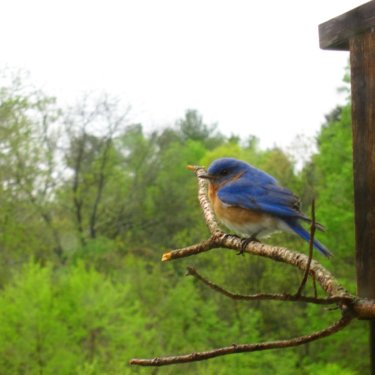Nature Conversations: Bluebirds
 Eastern Bluebirds are busy breeding now, utilizing nestboxes and tree cavities all around our region. Learn what they eat, their nesting strategies, and how you can support these delightful native songbirds.
Eastern Bluebirds are busy breeding now, utilizing nestboxes and tree cavities all around our region. Learn what they eat, their nesting strategies, and how you can support these delightful native songbirds.
Our Bluebird expert is Debbie Beer, the director of volunteer engagement here at Natural Lands. An avid birder, Debbie has traveled to a dozen countries for birding and wildlife safaris.
Here are highlights from our conversation with Debbie, originally presented on our Facebook page.
Bluebirds
Debbie: Hi everyone. Thanks for tuning in for bluebirds! They are one of our most beloved songbirds, flashing beautiful colors and singing from visible perches. They are considered harbingers of Spring.
Hi Debbie. What should we be putting out to feed our bluebirds?
Bluebirds eat insects, so if you avoid using chemicals, and plant a diversity of native perennials and grasses, they’ll be interested in your habitat. No need to feed them in warm months, but you could put out live mealworms for your wintering friends.
Can you suggest some native plants I can add to my garden that will support bluebirds?
Native plants are great for bluebirds, and all wildlife! Bluebirds are insectivores, so it’s good to plant perennials and shrubs that support insects. In the fall and winter, they survive on berries and fruits. Serviceberry, winterberry holly, viburnum, virginia creeper are good choices.
Bluebirds are one of my favorites – do they live here all year ’round or are they migratory?
Great question! Bluebirds are migratory species, but many local populations aren’t flying very far, if they can find food during the winter.
I see nesting boxes in pairs at Stroud. Is there a reason for this?
Pairs of nestboxes allow swallows to nest in one, and bluebirds will nest in the second one. Bluebirds are more timid, and swallows will generally “win” the competition for a box, but they’ll tolerate bluebirds to use a nearby box.
I see the Tree Swallows and the Eastern Bluebirds sharing nesting boxes. I assume they are at different times but are there issues during these times?
Tree swallows and bluebirds are both cavity-nesters, and compete for the same nestboxes. Swallows are more agressive, and will often “win” the competition. But bluebirds begin nesting earlier, and can establish a box if they get going before the swallows arrive.
Both species will nest within 10 feet of each other, if you install two different boxes. The swallow will not tolerate another pair of Tree Swallows nearby, but will allow the bluebird to occupy the adjacent box.
Do bluebirds raise young only once per year?
Bluebirds will raise 1-3 broods each year, averaging two. They start in mid-March, and stop nesting around July. The female lays 3-6 eggs, incubates for 14 days, then tiny chicks hatch and grow for about 3 weeks.
Are bluebird eggs blue?
Bluebirds lay blue, unmarked eggs. Robins also lay blue eggs, which you sometimes find on the ground. Bluebird eggs may occasionally be white. If you find a nest with mixed colors, it’s possible that the female consorted with a different male to produce the different color! They aren’t entirely faithful in a season.
I heard bluebirds were once scarce, are they doing OK now?
Bluebirds declined steadily in the 1900’s due to increased use of pesticides, and habitat destruction by felling and removing dead trees. Competition for nest holes is fierce, and bluebirds were losing to other cavity-nesting species including non-native House Sparrows and European Starlings. In the late 1970’s, severe winters reduced their numbers dramatically, and Eastern Bluebird became an endangered species. Their numbers have rebounded remarkably since volunteers started establishing and monitoring nestboxes.
What kind of habitat do bluebirds like?
Bluebirds prefer open space habitat like fields or natural-landscape golf courses with a few scattered trees. If you have some land like this, consider installing a nestbox to host them! The pole should be about 4 feet off the ground, with a predator guard around it (PVC pipe, or a wide baffle) to deter snakes, cats, and raccoons. Monitor the box once a week, and submit your data to eBird nestwatch. Natural Lands has 400+ boxes on our preserves, with 40 monitors – THANK YOU volunteers!
Debbie: Thanks everyone, for a great hour talking about beautiful bluebirds. Tune in again next Thursday for more fun bird talk. Stay safe, friends.
